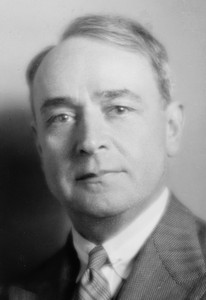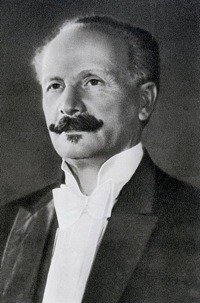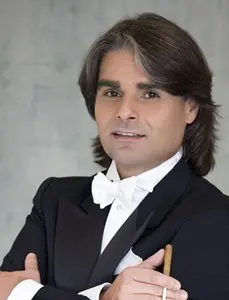
Sergey Alexandrovich Koussevitzky |
Serge Koussevitzky

A bright portrait of the master was left by the Russian cellist G. Pyatigorsky: “Where Sergei Alexandrovich Koussevitzky lived, there were no laws. Everything that hindered the fulfillment of his plans was swept out of the way and became powerless before his crushing will to create musical monuments … His enthusiasm and unerring intuition paved the way for youth, encouraged experienced craftsmen who needed it, inflamed the audience, which, in turn, inspired him to further creativity … He was seen in a rage and in a tender mood, in a fit of enthusiasm, happy, in tears, but no one saw him indifferent. Everything around him seemed sublime and significant, his every day turned into a holiday. Communication was for him a constant, burning need. Each performance is an exceptionally important fact. He possessed a magical gift to transform even a trifle into an urgent necessity, because in matters of art, trifles did not exist for him.
Sergey Alexandrovich Koussevitzky was born on July 14, 1874 in Vyshny Volochek, Tver province. If there is a concept of “musical wilderness”, then Vyshny Volochek, the birthplace of Sergei Koussevitzky, corresponded to it as well as possible. Even provincial Tver looked like the “capital” of the province from there. The father, a small craftsman, passed on his love of music to his four sons. Already at the age of twelve, Sergei was conducting an orchestra, which filled the intermissions in the performances of visiting provincial stars from Tver itself (!), And he could play all the instruments, but it looked like nothing more than child’s play and brought a penny. The father wished his son a different fate. That is why Sergey never had contact with his parents, and at the age of fourteen he secretly left the house with three rubles in his pocket and went to Moscow.
In Moscow, having neither acquaintances nor letters of recommendation, he came straight from the street to the director of the conservatory, Safonov, and asked to accept him to study. Safonov explained to the boy that studies had already begun, and he could count on something only for the next year. The director of the Philharmonic Society, Shestakovsky, approached the matter differently: having convinced himself of the boy’s perfect ear and impeccable musical memory, and also noting his tall stature, he decided that he would make a good double bass player. There was always a shortage of good double bass players in orchestras. This instrument was considered auxiliary, creating a background with its sound, and required no less effort to master itself than a divine violin. That is why there were few hunters for it – crowds rushed to the violin classes. Yes, and he required more physical effort both for playing and for carrying. Koussevitzky’s double bass went great. Just two years later, he was accepted into the Moscow private opera.
Double-bass virtuoso players are very rare, they appeared once in half a century, so that the public had time to forget about their existence. It seems that in Russia there was not a single one before Koussevitzky, and in Europe fifty years before that there was Bottesini, and fifty years before him there was Dragonetti, for whom Beethoven wrote specially the parts in the 5th and 9th symphonies. But the public did not see them both for long with double basses: both of them soon changed double basses to a much lighter conductor’s baton. Yes, and Koussevitzky took up this instrument because he had no other choice: leaving the conductor’s baton in Vyshny Volochek, he continued to dream about it.
After six years of work at the Bolshoi Theater, Koussevitzky became concertmaster of the double bass group, and in 1902 he was awarded the title of soloist of the imperial theaters. All this time, Koussevitzky performed a lot as a soloist-instrumentalist. The degree of his popularity is evidenced by invitations to take part in the concerts of Chaliapin, Rachmaninov, Zbrueva, the Christman sisters. And wherever he performed – whether it was a tour of Russia or concerts in Prague, Dresden, Berlin or London – everywhere his performances caused a sensation and a sensation, forcing one to remember the phenomenal masters of the past. Koussevitzky performed not only a virtuoso double-bass repertoire, but he also composed and made many adaptations of various plays and even concertos – Handel, Mozart, Saint-Saens. The well-known Russian critic V. Kolomiytsov wrote: “Whoever has never heard him play the double bass cannot even imagine what gentle and light-winged sounds he extracts from such a seemingly unrewarding instrument, which usually serves only as a massive foundation for an orchestral ensemble. Only very few cellists and violinists possess such beauty of tone and such mastery of their four strings.
Work at the Bolshoi Theater did not cause Koussevitzky satisfaction. Therefore, after marrying a student pianist of the Philharmonic School N. Ushkova, co-owner of a large tea trading company, the artist left the orchestra. In the autumn of 1905, speaking in defense of the orchestra artists, he wrote: “The dead spirit of police bureaucracy, which penetrated into the area where it seemed it should not have a place, into the area of uXNUMXbuXNUMXbpure art, turned artists into artisans, and intellectual work into forced labor. slave labor.” This letter, published in the Russian Musical Newspaper, caused a great public outcry and forced the theater management to take measures to improve the financial situation of the artists of the Bolshoi Theater Orchestra.
Since 1905, the young couple lived in Berlin. Koussevitzky continued active concert activity. After the performance of the cello concerto by Saint-Saens in Germany (1905), there were performances with A. Goldenweiser in Berlin and Leipzig (1906), with N. Medtner and A. Casadesus in Berlin (1907). However, the inquisitive, searching musician was less and less satisfied with the concert activity of the double-bass virtuoso: as an artist, he had long “grown” out of a meager repertoire. On January 23, 1908, Koussevitzky made his conducting debut with the Berlin Philharmonic, after which he also performed in Vienna and London. The first success inspired the young conductor, and the couple finally decided to devote their lives to the world of music. A significant part of the large fortune of the Ushkovs, with the consent of his father, a millionaire philanthropist, was directed to musical and educational purposes in Russia. In this field, in addition to artistic, outstanding organizational and administrative abilities of Koussevitzky, who founded the new Russian Musical Publishing House in 1909, manifested themselves. The main task set by the new music publishing house was to popularize the work of young Russian composers. At the initiative of Koussevitzky, many works by A. Scriabin, I. Stravinsky (“Petrushka”, “The Rite of Spring”), N. Medtner, S. Prokofiev, S. Rachmaninov, G. Catoire and many others were published here for the first time.
In the same year he assembled his own orchestra of 75 musicians in Moscow and began concert seasons there and in St. Petersburg, performing all the best that was known in world music. This was a unique example of how money begins to serve art. Such activity did not bring income. But the popularity of the musician has increased tremendously.
One of the characteristic features of Koussevitzky’s creative image is a heightened sense of modernity, a constant expansion of repertoire horizons. In many ways, it was he who contributed to the success of Scriabin’s works, with whom they were linked by creative friendship. He performed the Poem of Ecstasy and the First Symphony in London in 1909 and the following season in Berlin, and in Russia he was recognized as the best performer of Scriabin’s works. The culmination of their joint activity was the premiere of Prometheus in 1911. Koussevitzky was also the first performer of the Second Symphony by R. Gliere (1908), the poem “Alastor” by N. Myaskovsky (1914). With his extensive concert and publishing activities, the musician paved the way for the recognition of Stravinsky and Prokofiev. In 1914 there were premieres of Stravinsky’s The Rite of Spring and Prokofiev’s First Piano Concerto, where Koussevitzky was the soloist.
After the October Revolution, the musician lost almost everything – his publishing house, symphony orchestra, art collections, and a millionth fortune were nationalized and expropriated. And yet, dreaming about the future of Russia, the artist continued his creative work in the conditions of chaos and devastation. Being captivated by the tempting slogans “art to the masses”, consonant with his ideals of enlightenment, he participated in numerous “folk concerts” for the proletarian audience, students, military personnel. Being a prominent figure in the musical world, Koussevitzky, along with Medtner, Nezhdanova, Goldenweiser, Engel, participated in the work of the artistic council at the concert sub-department of the music department of the People’s Commissariat of Education. As a member of various organizational commissions, he was one of the initiators of many cultural and educational initiatives (including the reform of music education, copyright, the organization of the state music publishing house, the creation of the State Symphony Orchestra, etc.). He led the orchestra of the Moscow Union of Musicians, created from the remaining artists of his former orchestra, and then was sent to Petrograd to lead the State (former Court) Symphony Orchestra and the former Mariinsky Opera.
Koussevitzky motivated his departure abroad in 1920 by the desire to organize the work of a foreign branch of his publishing house. In addition, it was necessary to conduct business and manage the capital of the Ushkov-Kusevitsky family, which remained in foreign banks. Having arranged business in Berlin, Koussevitzky returned to active creativity. In 1921, in Paris, he again created an orchestra, the Koussevitzky Symphony Concerts society, and continued his publishing activities.
In 1924, Koussevitzky received an invitation to take the post of chief conductor of the Boston Symphony Orchestra. Very soon, the Boston Symphony became the leading orchestra, first in America, and then the whole world. After moving permanently to America, Koussevitzky did not break ties with Europe. So until 1930 Koussevitzky’s annual spring concert seasons in Paris continued.
Just as in Russia Koussevitzky helped Prokofiev and Stravinsky, in France and America he tried in every possible way to stimulate the creativity of the greatest musicians of our time. So, for example, for the fiftieth anniversary of the Boston Symphony Orchestra, which was celebrated in 1931, works by Stravinsky, Hindemith, Honegger, Prokofiev, Roussel, Ravel, Copland, Gershwin were created by special order of the conductor. In 1942, shortly after the death of his wife, in her memory the conductor founded the Musical Association (publishing house) and the Foundation. Koussevitskaya.
Back in Russia, Koussevitzky showed himself as a major musical and public figure and a talented organizer. The very enumeration of his undertakings may cast doubt on the possibility of accomplishing all this by the forces of one person. Moreover, each of these undertakings left a deep mark on the musical culture of Russia, France, and the United States. It should be especially emphasized that all the ideas and plans implemented by Sergei Alexandrovich during his life originated in Russia. So, in 1911, Koussevitzky decided to found the Academy of Music in Moscow. But this idea was realized only in the USA thirty years later. He founded the Berkshire Music Center, which became a sort of American musical mecca. Since 1938, a summer festival has been constantly held in Tanglewood (Lennox County, Massachusetts), which attracts up to one hundred thousand people. In 1940, Koussevitzky founded the Tanglewood Performance Training School in Berkshire, where he led a conducting class with his assistant, A. Copland. Hindemith, Honegger, Messiaen, Dalla Piccolo, B. Martin were also involved in the work. During World War II, Sergei Alexandrovich led the fundraising for the Red Army, becoming chairman of the Committee for Assistance to Russia in the War, was president of the music section of the National Council of American-Soviet Friendship, and in 1946 took over as chairman of the American-Soviet Musical Society.
Noting the merits of Koussevitzky in the musical and social activities of France in 1920-1924, the French government awarded him the Order of the Legion of Honor (1925). In the United States, many universities awarded him the honorary title of professor. Harvard University in 1929 and Princeton University in 1947 awarded him an honorary Doctor of Arts degree.
Koussevitzky’s inexhaustible energy amazed many musicians who were close friends with him. At the age of seventy in March 1945, he gave nine concerts in ten days. In 1950, Koussevitzky made a big tour to Rio de Janeiro, to the cities of Europe.
Sergei Alexandrovich died on June 4, 1951 in Boston.





